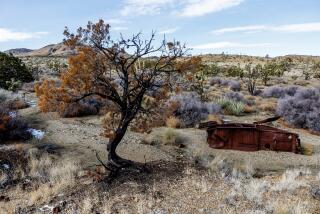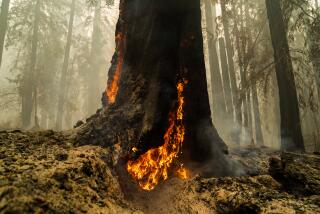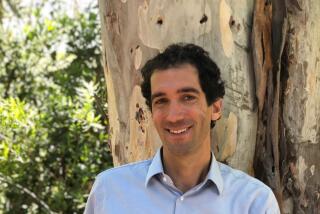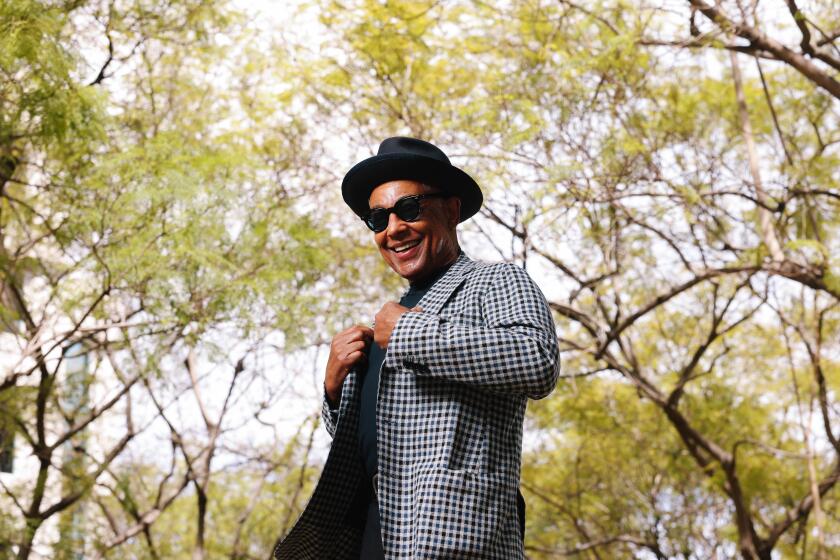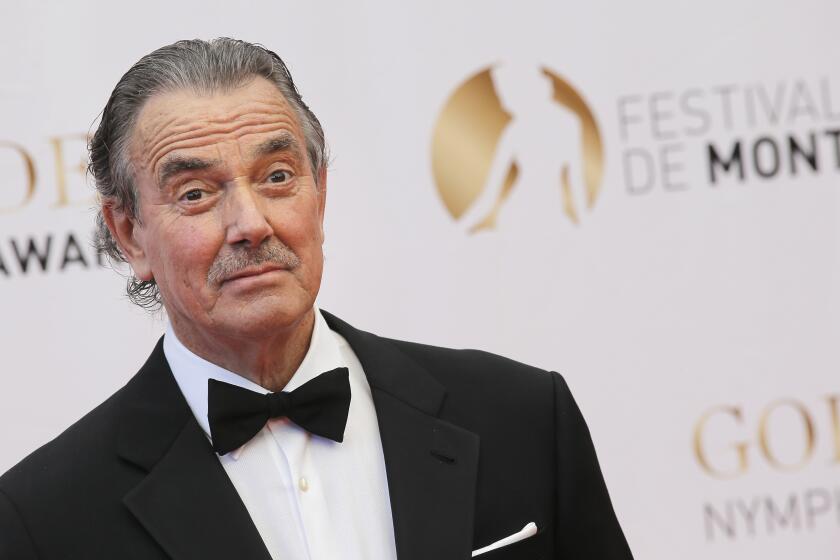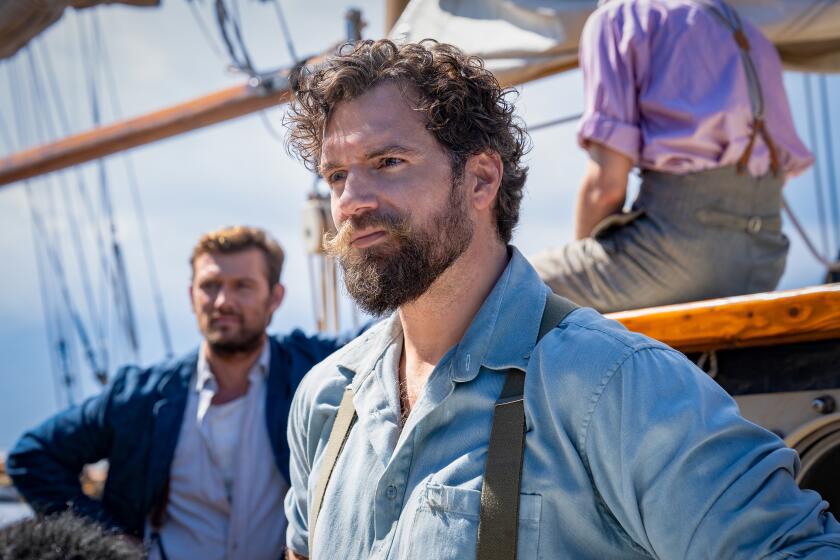‘The Big Burn’ by Timothy Egan
The Big Burn
Teddy Roosevelt and the Fire
That Saved America
Timothy Egan
Houghton Mifflin Harcourt: 324 pp., $27
During 18 years with the New York Times, many as the paper’s Pacific Northwest correspondent, Timothy Egan wrote several nonfiction books describing the lives and dreams of Westerners, as shaped by their connection with the land. (He also wrote a novel, “The Winemaker’s Daughter,” exploring similar themes.)
“The Worst Hard Time,” which won the National Book Award in 2006, was Egan’s first nonfiction book that did not begin with reporting for the paper. Perhaps not coincidentally, it was also his first book written in a voice cut free from a mannered style. Weaving stories of land speculators, politicians and bureaucrats with chronicles of ranch hands, homesteaders and other settlers whose hopes for profit, comfort or a fresh start were dashed by the natural disaster of the Dust Bowl, the structure of “The Worst Hard Time” was as unexpected and intricate as the gnarled sphere of a tumbleweed.
A modest epic of American folk art, the book is animated by diaries, oral histories and vintage news reports describing the endurance of otherwise forgotten people and suggesting wisdom for an age that may face similarly dire environmental prospects. When a man who has every reason to leave a place that’s almost suffocated him makes the surprising decision, instead, to stay, Egan observes, “It takes a certain kind of person to make peace with land that has betrayed them, but that is the way with home.”
Egan’s new book, “The Big Burn: Teddy Roosevelt and the Fire That Saved America,” about the biggest forest fire in American history, is another wholesale departure from his reporting. It succeeds to the same degree as the last book, in many of the same ways -- but with an important difference. Like “The Worst Hard Time,” it’s a complex, tragic story of reckoning with nature’s imperturbable power, reconstructed at the grass-roots level of social history. But in addition, “The Big Burn” serves a big helping of Great Man history, with some familiar, larger-than-life characters acting out a morality tale that delivers a satisfying kick.
Leading Egan’s team of good guys are Theodore Roosevelt and his close advisor and friend, the pioneering forester Gifford Pinchot. Upon Roosevelt’s 1901 ascension to the presidency, they worked together to curtail corporate plunder of the country’s natural resources. Pinchot, bullheaded and indiscreet, was practically Roosevelt’s soul mate and possibly even more eccentric than the president. Pinchot’s diaries, found after his death, reveal that during the height of his power, Pinchot was secretly consulting with the ghost of his late fiancée: “He read books to her, ran his ideas and speeches by her, craved her approval, checked opinions and policies with her,” Egan writes.
The bad guys are the plunderers: the greedy owners of the timber companies, mines and railroads, and the congressmen who did their bidding. The most venal of them all, with a foot in both camps, was Montana Sen. William A. Clark (“as rotten a human being as can be found anywhere under the flag,” wrote Mark Twain), a copper mining magnate (and the founder of Las Vegas) who boasted, “I never bought a man who was not for sale.”
In 1905, after Roosevelt’s landslide election to a full term, he made Pinchot head of the new U.S. Forest Service and eventually placed 180 million acres of the West under protection. Roosevelt saw this as a bulwark against the frontier’s capitalistic free-for-all: he wanted people to “understand that it was their right in a democracy to own it -- every citizen holding a stake,” Egan writes. Roosevelt also wanted Americans to experience wilderness as an antidote to what his friend John Muir called the “stupefying effects of the vice of over-industry and the deadly apathy of luxury.”
Congress did not want to fund these big ideas. What little money the Forest Service got Pinchot won by making an impossible promise: He vowed that his hand-picked forest rangers -- a band of well-educated greenhorns whose devotion to him earned them the nickname “Little G.P.s” -- would put an end to the wildfires that threatened burgeoning commercial interests in the West. Pinchot knew that fire was an essential part of the natural life cycle of the forest, but, Egan notes, he seems to have convinced even himself “that nature could be subdued even as it was preserved, an inherent contradiction.”
Pinchot clashed with Roosevelt’s successor, William Howard Taft, and got himself fired in early 1910, a rupture that put his and Roosevelt’s plans for the forests at risk. That July, locomotives and lightning strikes on drought-stricken land in the western U.S. sparked 3,000 fires that spread until finally, on Aug. 20, they were united by a western wind called a Palouser, functioning as “a battering ram of forced air” that, over the course of a weekend, would ignite 3 million acres, an area larger than Yellowstone National Park.
The Little G.P.s scrambled to rally a ragtag group to fight the fire, including prisoners, immigrants and soldiers (including the 25th Infantry, the all-black regiment known as the Buffalo Soldiers). Egan conjures dozens of characters from the smoke, recounting their suspenseful work, and the infernal spectacle “of trees swelling, sweating hot sap and then exploding, of horses dying in seconds; of small creeks boiling, full of dead trout, their white bellies up, of bear cubs clinging to flaming trees, wailing like sobbing children.” The conflagration stretched from Idaho through Montana, Washington, British Columbia, devastated towns like Taft, Mont. (which had “one prostitute for every three men and a murder rate higher than that of New York City”), and claimed the lives of almost 100 men.
Switching among various subplots and sets of characters, “The Big Burn” describes social ecosystems of extreme moral complexity, where the well-intentioned are as vulnerable to hubris as the villains, and fate pays scant respect to justice. Most of the heroic firefighters received little recognition for their sacrifices. Elers Koch, whose life after the fire was a series of losses and frustrations, wrote a book about his career that nobody would publish, and finally killed himself. Forty-four years later, his book was published to acclaim. Another, a ranger named Ed Pulaski, who saved 40 men but lost most of his eyesight in the fire, received no financial compensation from the government and died poor and embittered. He is now revered, second only to Pinchot, as a founding father of the Forest Service.
The fire “saved America,” in Egan’s phrase, because it galvanized the emerging conservation movement and persuaded the public that more forests needed federal protection. In 1911, Congress passed a law that would eventually allow government purchase of 20 million acres of woodland in the East, vindicating Roosevelt and Pinchot’s thwarted mission. That’s the Great Men’s moral victory that redeems the common people’s excruciating suffering, the high purpose that fires “The Big Burn.”
Of all its characters, “The Big Burn’s” most vivid is Gifford Pinchot, whom Egan treats with empathy and affection. In his 70s, Pinchot drove his Buick 5,000 miles for a last look at the forests that he had ceaselessly fought to protect for posterity, an accomplishment that Egan ranks with Michelangelo’s masterworks.
Muir called Pinchot “someone who could relish, not run from a rainstorm” -- a phrase that also describes “The Big Burn’s” narrator. For as long as Egan keeps chasing storms, whether of dust, fire, rain or snow, you’d be smart to call shotgun.
Gross is the author of “Starstruck: When a Fan Gets Close to Fame.”
More to Read
The biggest entertainment stories
Get our big stories about Hollywood, film, television, music, arts, culture and more right in your inbox as soon as they publish.
You may occasionally receive promotional content from the Los Angeles Times.
